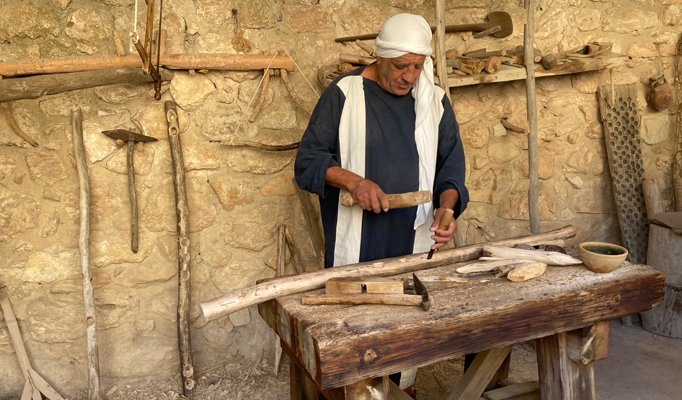
Walking in the steps of Jesus can be a transformational experience for many as they see the places where much of our Scripture played out.
Have you ever wanted to time travel? Walking back to 2,000 years ago becomes a lot easier when you have something visible and tangible to experience. Nazareth Village is one such place. One hundred thousand people a year stroll through the authentic recreation discovered or developed on site near where the original home of Joseph and Mary stood.
Modern day Nazareth is the largest city in the Galilee and is known as the Arab capital of Israel. It’s 80,000 residents (250,000 including the surrounding area) are comprised of 70 percent Muslim and 30 percent Christian. The original vision for the ‘Village’ site came from Dr. Nakhle Bishara who consulted archaeological digs able to uncover 20 centuries of life and culture. He stated that “there is a deep desire on the part of all who come to Nazareth to see Jesus. But for centuries, all they could see was dusty stones. That is why I proposed a place where visitors could see those ancient stones come to life and witness the vineyards and olive trees where Jesus used to teach spiritual truth.”
Our group of 25 lunched on authentic first century cuisine before enjoying a tour of the open-air museum including vintners, shepherds, farmers, rabbis, weavers and builders. Staff and volunteers keep the centre vibrant with first century dress and activity. The working farm, olive press, quarry, weaver’s shuttle and cultivated grain fields are used to bring the parables of Jesus to life. Tour guides draw attention to the cultivated terraces, the watchtower, the quarries, winepress, ancient olive trees and then a first-century synagogue.
There are several significant lessons to learn from this look back into ancient Nazareth. We are told that the off-shoots from the roots of ancient olives are called neser or branch and that these are transplanted to bring new olive trees. Jesus is referred to as a neser (Isaiah 11:1) and is seen as a transplant from Jesse’s ancestral home in Bethlehem. The early town seems to have taken root in the lower centre of the bowl-shaped hillock.
Another great lesson is seen when the olives are pressed three times to extract the maximum level of oil. The first crushing and pressing results in a pulp which is put under severe weights. The first oil is the purest and is used for temple and synagogue ceremonies. The oil from the second pressing is used for food, for medicinal purposes, and for home life. The third pressing results in oil for lamps etc. The lesson is drawn that the olive is a symbol of Israel and that Jesus as a ‘son of Israel’ was pressed three times through his prayers in the garden of Gethsemane at an olive press on the night before he was crushed for our iniquities.
Booking ahead is essential and since this is excavated on the original hillsides of Nazareth there is little option for anyone with mobility issues. For those who can walk, this is a highlight you won’t want to miss.
An interesting sidenote is that the land for this project once sat on the premises of the Scottish Hospital (part of the Edinburgh Medical Missionary Society started in 1861). In the 1860s, health was poor and the 5,000 residents of Nazareth, living under the control of the Ottoman Empire, were living an average of 22 years for men and 24 for women. Inspired by the work of Florence Nightingale, Dr. Kaloost Vartan stepped into an arena of cholera, dysentery, malaria and tuberculosis with a high infant mortality. Traditional medicine involved cauterization, bloodletting, bonesetting, cupping, leeching and tribal herbal applications. The local practitioners worked hard to undermine Vartan’s introduction of chloroform anesthesia for surgeries and his practice in general. The hospital land was purchased in 1879 and most of it sat idle until an archaeologist stumbled over a winepress. In 2001, the EMMS split into two trusts and Nazareth Trust holds the oversight to the 500 volunteers who serve in the hospital or the village throughout the year.
There are other sites to see in Nazareth. The largest Roman Catholic church in the Middle East is the Church of Annunciation in Nazareth. This is the place where it is held that the angel Gabriel announced his good news to Mary. Alternatively, the Church of St. Gabriel protects the original springs designated by the Greek Orthodox as the site for the annunciation. The Synagogue Church, maintained by the Melkite Greek Catholic Church, is the traditional site for the synagogue where Jesus preached his famous Isaiah 61 message before he was ejected and relocated to Capernaum.
Luke 4:28-29 says “All the people in the synagogue were furious when they heard this. They got up, drove him out of the town, and took him to the brow of the hill on which the town was built, in order to throw him off the cliff.”
At 395 metres, Mt. Precipice is the highest point in the Nazareth area, a few kilometers from the city centre. It is the traditional place where the mob took Jesus to throw him off a high cliff. From that vantage point you can get a great view of the Jezreel valley where Gideon fought, Mt. Gilboa (where Saul and Jonathan perished), the Mount of Transfiguration, the town of Nain (where Jesus raised the widow’s son) and many other sites of biblical significance. From here you can look down into the heart of Nazareth, see rock hyrax, a mustard seed plant and enjoy a fresh glass of pomegranate juice from a vendor.
For any tour of Israel, Nazareth is a must see stop as you slow down a bit to get a feel for the life and parables of Jesus.

Leave a Reply